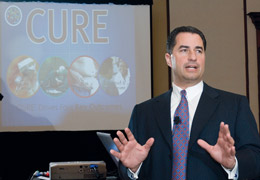Marketing
Start with the carrot
Wellness comes of age
By Dennis H. Pillsbury
On paper, wellness looks like a great idea. People are healthier, health care costs go down, and we live longer and happier lives. But as with many things, the devil is in the details. And one of the most important details is that wellness involves changing the habits of people.
We’d all like to live longer and healthier lives and be physically fit, as long as that doesn’t involve sweating and eating “rabbit food,” and giving up those habits that are just, oh, so much fun.
Of course, we all know people who tell us about how exercise can become a habit and how much fun it is when the endorphins kick in. Right. Then why isn’t every runner I see grinning from ear to ear?
So how do we convince people that wellness works?
Robert J. Klonk, RHU, REBC, executive vice president and director of group benefits with The Oswald Companies, an independent consultative insurance brokerage and risk management firm based in Cleveland, Ohio, maintains that “you need to start with the carrot.”
The Oswald Companies has “made wellness a part of our practice for the last eight years,” Bob points out. “We realized early on that you had to get to the underlying cost drivers to have an impact on health care costs. And we also recognized that the best way to get people to change their habits and adopt a healthy lifestyle was to make it worth their while.”
Instead of using the negative reinforcement that has traditionally been used by the insurance industry—the “if you don’t change, it’ll cost you” approach—Oswald decided to design a program that “offers meaningful incentives for people to change behaviors,” Bob points out. “At the same time, the program also offers guaranteed cost reductions for both group health coverage and workers compensation.”
The revolutionary program, CURE™, promises four outcomes, which make up the acronym:
• Cost control
• Utilization improvement
• Risk reduction
• Education and engagement
Oswald began unveiling the particulars of the CURE program on March 1, following several years of development.
“Wellness has followed a continuum where we continued to enhance our offerings to better serve our clients,” Bob notes. “CURE represents an evolution of this effort, utilizing all the best wellness practices we have developed from the experience of our clients and our agency, where wellness is part of the culture as well. We don’t just talk the talk,” Bob observes. “We also walk the walk.
“Where necessary, we have struck strategic alliances with companies that provide wellness services that are outside our purview but that we see as an essential ingredient in creating a complete wellness program that ultimately will lead to a healthier, happier workforce.”
At a recent presentation to clients in the Columbus, Ohio, area, Bob explained that the program was designed to address the concerns of two disparate groups within a corporation—finance and human resources. “The CFO wants costs reduced,” Bob pointed out. “And those costs need to be reduced yesterday.
“Meanwhile,” he continued, “human resources wants employees to be happy with their benefits and to stay that way basically forever. And one of the ways to make employees happy is to provide a richer benefits package.
“Clearly, there’s a seemingly insurmountable dichotomy there, where finance wants short-term results that could easily impact negatively the long-term goals of human resources. We saw our goal as achieving a solution that responds to both needs. And I think you can understand why it took several years to research and design a solution.”
The “duh” factor
“No question is so difficult to answer as that to which the answer is obvious.”—George Bernard Shaw
In essence, the answer came straight out of Insurance 101—the greater the risk, the higher the cost. And, in the case of health care, the risks include smoking, obesity, high blood pressure, high cholesterol, and so on. And the statistics back that up. Bob pointed out that the average annual health care cost for an individual with one risk factor is $5,018; for someone with three, it’s $8,071; with five, it’s $11,596; and with seven, it’s $15,209. So the simple answer is to reduce the risk factors. That cuts costs for the CFO and also results in a happier, healthier work force to satisfy HR.
If you consider most of the solutions to soaring health care costs that have been propounded thus far, they focus on reducing costs through management of high cost claimants. Disease management encourages the best, most cost-effective treatments for a particular disease. Benefit integration cuts costs by reducing the expenses inherent in dual systems. But very little focuses on mitigation. Disease management, for example, is after the fact of the disease. How about disease prevention instead?
One of the growing health problems in this country is diabetes. And, for many people, this is a preventable problem. Proper diet and weight control can greatly reduce the number of people faced with this disease. Heart disease is another example. Manage-ment of blood pressure, cholesterol, weight, and alcohol and tobacco consumption can greatly reduce the risk of heart disease. And no one wants to have diabetes or heart disease. Yet we continue to engage in the bad habits that could lead to one or both. We want to do better, but that little guy with the horns and pitchfork sitting on our shoulder is there to whisper in our ears how much fun it would be to … Or how much easier it would be to … And so on and so on and so on.…
At least in my case, the angel on the other shoulder speaks up only after the fact to remind me that I really shouldn’t have skipped my time on the treadmill, or had that second helping.
And that brings us to the solution for HR—on-site, in-person health coaching so that people don’t have to rely on the appearance of that angel on the shoulder. They have ongoing help right on the factory floor or in the office environment. “In addition to guiding employees to reach their lifestyle goals, these coaches also will make ‘safety sweeps’ around the business,” Bob notes. “If a coach sees someone lifting incorrectly, for example, he will remind the person how he or she is supposed to lift, bending the knees and letting the legs—not the back—do the work. The objective is to replace bad habits with good ones.”
The simplicity of the solution was reinforced by Bob’s 7-year-old daughter, who upon hearing about the CURE responded: “Well, duh.”
In addition to on-site coaching, Bob continues, the program also offers monetary incentives to employees who meet certain wellness goals. Employees can receive deductible credits to their health care insurance for stopping or never smoking, and for meeting weight, blood pressure, and cholesterol benchmarks. Spouses also can qualify in the same manner. “We’ve set the goals at reasonable levels,” Bob notes. “We aren’t trying for Olympic athletes; we just want people to get healthier.
“In the first year,” he continued, “the goals for employees involve attending a class or two on various wellness topics that will be offered on site, and taking a health risk assessment with blood screening. This gives each person their baseline health numbers. If they’re smokers, they have to quit to qualify for one of their credits and agree to be assessed annually. We start the program after some six to nine months of explanation and communication, so employees have time to work toward their goal. And we don’t just walk in and say, ‘Here it is.’ We’re there every step of the way with health management services and safety diagnoses so that employees know what they need to do and how to accomplish it.”
Neil E. Quinn, MS, director of health management services, adds that “CURE is a sustainable program that is fair for employees, while providing guaranteed cost reduction for employers.” Quinn, who is a kinesiologist, heads up a staff of health care professionals that focuses on providing prevention services and health risk management for Oswald clients.
“The program will help individuals decrease their health risk factors and as a result, live healthier, happier lives,” Neil continues. “As the impact of this wellness approach grows, companies that adopt it will see a decrease in disease onset and an improvement in employee morale and productivity overall.”
Bob concluded: “The game plan is simple. We will give employees all the resources they need to become healthier and more productive and they decide whether they want that or not.” * |
|
Click on image for enlargement |
 |
| |
“We realized early on that you had to get to the underlying cost to have an impact on health care cost drivers. And we also recognized that the best way to get people to change their habits and adopt a healthy lifestyle was to make it worth their while.”
—Robert J. Klonk, RHU, REBC Executive Vice President and Director of Group Benefits
The Oswald Companies
Cleveland, Ohio |
| |
“CURE is a sustainable program that is fair for employees, while providing guaranteed loss reduction for employers.”
—Neil E. Quinn, MS
Executive Vice President
and Director
Health Management Services |
| |
 |
|
|


